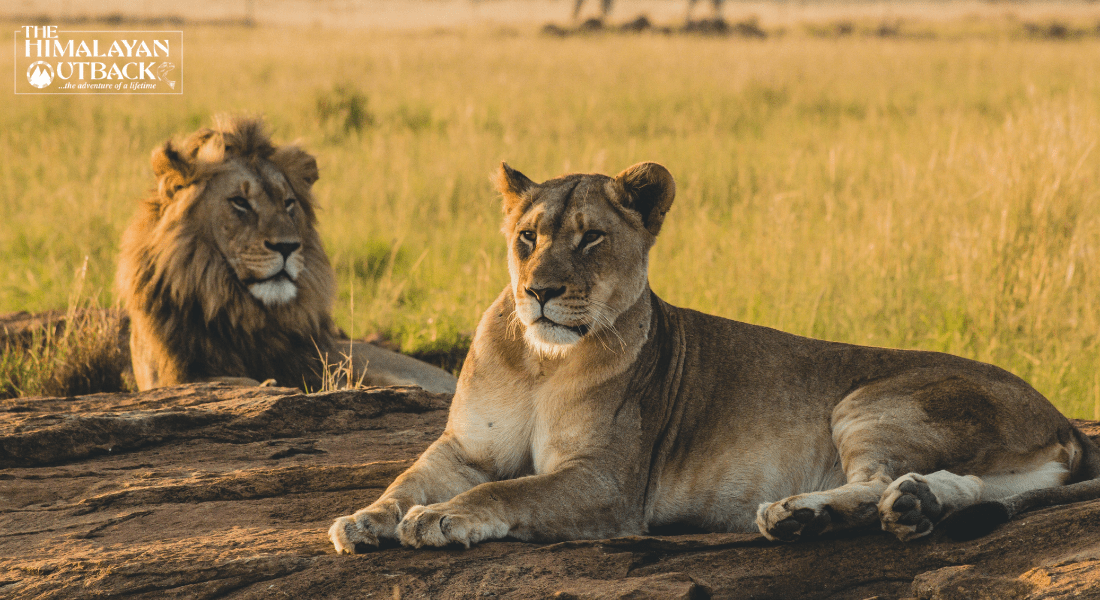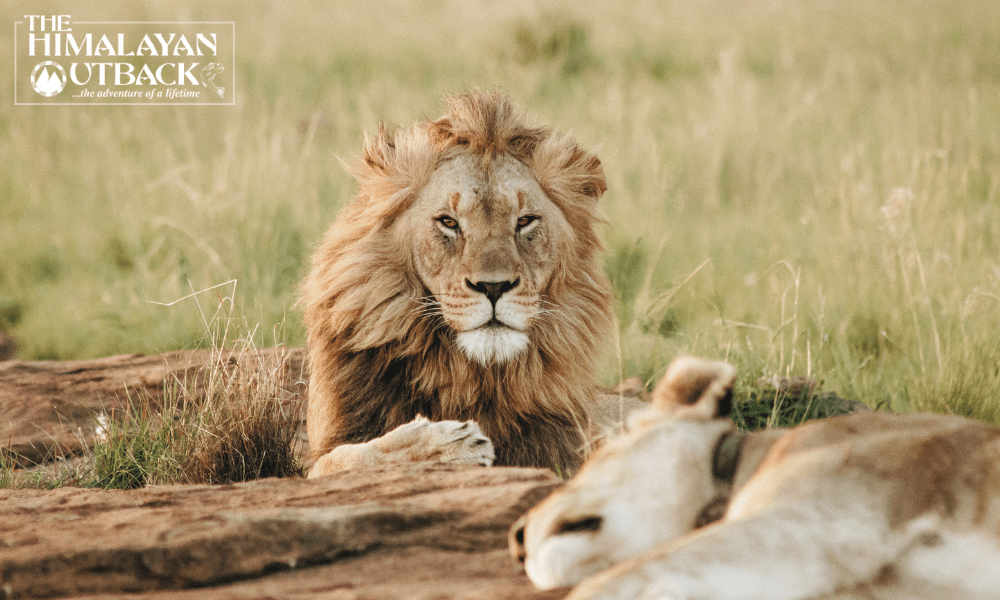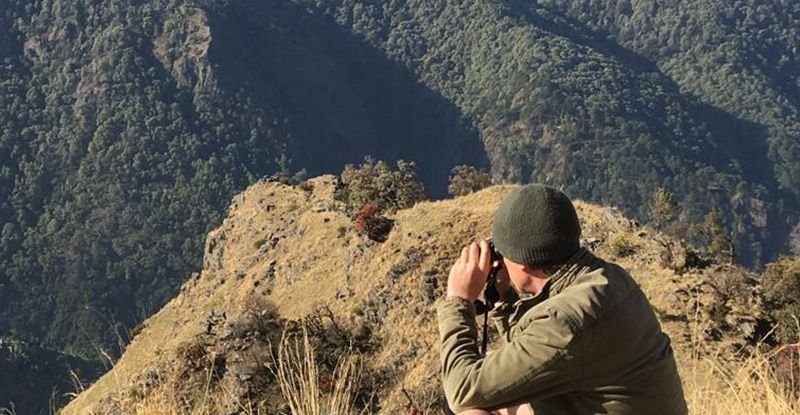Lions are one of Africa’s most recognisable animals, and for good reason: lions represent courage, strength, and power more than any other animal in the African wilderness. They are the most sedentary of the big cats – sleeping or resting up to 20 hours a day. They can be found lying on their backs with their feet up or sleeping in the shade. They are very affectionate towards one another while lazing around, rubbing heads, grooming, and purring.
The Himalayan Outback brings you some interesting facts about lions that you will enjoy. Have a read.

SOCIAL BEHAVIOUR
Lions are the most extrovert of the big cats. They live in prides which are usually made up of related females and their offspring. A typical pride consists of ten to fifteen lions, including several adult females, cubs, and up to four males. Some lion prides can have up to 40 members!
DIET
Lions can go up to four days without water, but if water is available, they will drink it every day – however, they must eat every day. Adult female lions require about 11 pounds of meat per day, while adult males require 16 pounds or more. While lions primarily prey on large herbivores like zebra, wildebeest, and buffalo, they have also been observed preying on mice, birds, hares, lizards, and tortoises.
MOST HUNTING IS DONE BY FEMALE LIONS
The pride’s primary hunters are the lionesses. They are smaller and more agile than males, and they work together to bring down an animal. Following a successful hunt, the pride’s lions share the meal. However, there is a pecking order, with adult males eating first, followed by lionesses, and then the cubs. The males defend the pride and its territory (which can cover up to 100 square miles) from competing prides and other predators. Females in a given pride are responsible for 85-90 percent of the hunting.
EXCELLENT HUNTERS.
Ambush hunting is how lions hunt. They form a semicircle by fanning out, with the smaller lionesses herding the prey towards the centre. The vision of a lion is approximately six times more sensitive to light than that of humans, giving them a distinct advantage when hunting at night. The lion’s claws are retractable, reaching up to 12 inches in length, giving it incredible control when it needs to go in for the kill. Lions can also run at speeds of up to 50 miles per hour for short periods of time and jump up to 36 feet. So it’s easy to understand why the lion is known as the “king of the jungle”.
HABITAT
Although lions are known as the “king of the jungle,” they do not live in a jungle in Africa. Their primary habitats are instead Africa’s grasslands and plains. Three of the five largest lion populations can be found in Tanzania’s vast savannas.
COMMUNICATION
Lions communicate in a variety of ways, including roars, growls, moans, and grunts. In addition, scent markings and visual cues, such as the darkness of the mane, are used. They also rub their heads against one another to bond and spread the “family scent.” The roar of a lion can be heard up to 5 miles away. This is a warning to other predators, as well as a means of protecting their territory from competing males and attracting mating partners.
LARGE FAMILIES
Females in the same pride have a tendency to give birth around the same time, allowing multiple litters to be raised together. Lionesses will care for their cubs until they are two or three years old. The mother then enters estrus (the heat cycle) and bears another litter. This is when pride drives the male and some of the female lion cubs away. They must now fend for themselves or seek another pride. Male lions do not actively participate in parenting, but they do protect the pride’s cubs from harm. Did you know that lion cubs go by different names? Though they are commonly referred to as cubs, lion babies are also known by two other names: “whelps” and “lionets”.
THE LION CUB
Cubs are born very small, with their eyes closed until they are two to three weeks old. Even so, they won’t be able to see properly for a few weeks. They are vulnerable to attacks from large birds, snakes, and even male lions at this time. For about six weeks, a lioness will keep her cubs hidden from other lions until they are old enough to follow the pride. Lion cubs are full of energy and grow up playing with the rest of the pride’s children. They can be seen leaping, rolling, and biting gently. This type of play strengthens family bonds and builds strength.
LIONS ARE THE WORLD’S SECOND LARGEST CAT.

The lion is the second largest big cat, only slightly smaller than the Siberian tiger, with a muscular, deep-chested body, short, rounded head, round ears, and a hairy tuft at the end of its tail. Lions, unlike all other big cats that hunt alone, are social animals that live in prides. Male lions can grow to be 10 feet long and weigh up to 550 pounds, while female lions can grow to be 9 feet long and 390 pounds.
LIONS ONCE EXISTED IN EUROPE.
To see lions in large numbers today, you must travel to eastern or southern Africa on a safari. However, fossils and historical records indicate that lions once roamed Egypt and northern Africa. Lions were once found throughout most of Greece, Bulgaria, and neighbouring countries in Europe. Lions once roamed the African continent, the Middle East, and Asia, with populations in Turkey, Saudi Arabia, and Pakistan. Today, India is the only country outside of Africa with wild lions, with only a small population surviving in and around the Gir National Park.
CAPABLE OF CLIMBING TREES
Most lions spend their entire lives on the ground, but in some African parks, they have learned to climb trees. They are not adept at climbing & are not as graceful as leopards when climbing trees. Most lion prides do not climb trees, and large males are less likely to do so because they are so heavy. The reason lions climb or sleep in trees is to avoid flies and insects on the ground. It can be cooler up in a tree, and they have a better view of any other animals nearby.
Lions may also be forced to climb a tree in order to flee an enraged herd of buffaloes. Tanzania and Uganda are the most popular destinations for these unique tree-climbing lions. The best places to see them are Queen Elizabeth National Park, Lake Manyara National Park, Lake Nakuru National Park, and Tarangire National Park.
ENDANGERED SPECIES
Three-quarters of all African lion populations are declining. With only about 20,000 remaining in the wild, they are officially classified as vulnerable to extinction. Even though they are powerful and majestic, and have no natural predators, it is unfathomable that African lion populations have declined by more than 40% in the last 30 years. Loss of territory, lion/human conflict, and trophy hunting are the three most serious threats to lions. As a traveller, you can help by visiting national parks and game reserves that dedicate resources to protecting Africa’s lions.
Book your wildlife safari trip with The Himalayan Outback and have a memorable trip.








7 Responses
http://doxycyclinedelivery.pro/# doxycycline 20 mg
https://clomiddelivery.pro/# can i buy clomid
amoxicillin tablets in india [url=https://amoxildelivery.pro/#]generic for amoxicillin[/url] buy amoxicillin 500mg uk
https://doxycyclinedelivery.pro/# doxycycline hyc 100 mg
http://doxycyclinedelivery.pro/# doxycycline prescription coupon
Paxlovid buy online [url=https://paxloviddelivery.pro/#]Paxlovid buy online[/url] paxlovid cost without insurance
http://amoxildelivery.pro/# buy amoxicillin online uk
https://amoxildelivery.pro/# amoxicillin 250 mg capsule
paxlovid generic [url=https://paxloviddelivery.pro/#]paxlovid covid[/url] paxlovid price
https://amoxildelivery.pro/# can you buy amoxicillin over the counter in canada